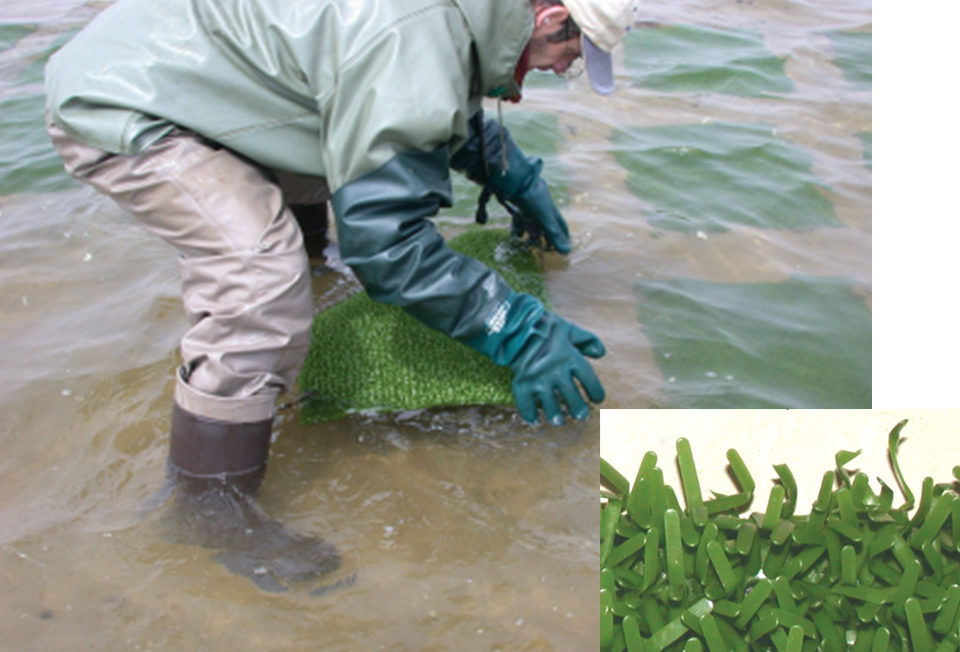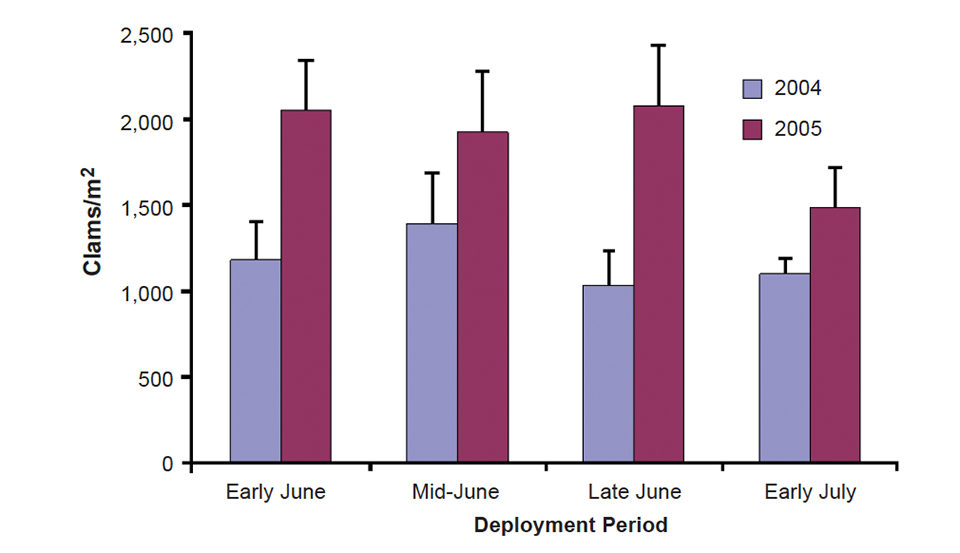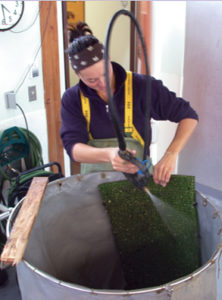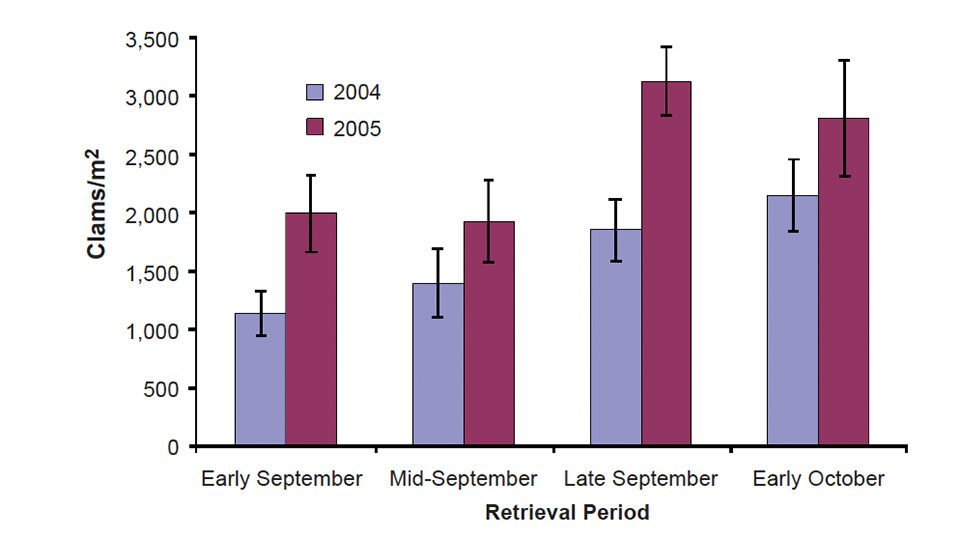Mats laid on the substratum increase local spat settlement

The first research to develop soft-shell clam culture in Îles-de-la-Made-leine on Canada’s southern Gulf of St. Lawrence began in 1994. Since then, one recurrent constraint has been a secure seed supply.
During the early years of study, the focus of attention was on suspension collection using scallop bags filled with a polyethylene material to increase surface area, but results were disappointing. Although clam collection up to 1,000 per bag was possible, the huge abundance of associated mussel spat in the bags made it of very limited commercial interest because of sorting constraints. As a result, the MIM soft-shell clam culture program put in place in 2000 focused primarily on the harvesting of small 15- to 40-mm clams from a wild population as a source of seed supply.
Once again, the results were disappointing because of the very poor growth and high losses of these clams once seeded. Nets were also deployed as “tents” to increase spat settlement, but with no success. Since hatchery production is an expensive way to get small clams, very few options were still available to secure spat supply in order to develop profitable clam culture in Îles-de-la-Madeleine.
New approach
Since 2002, the authors have looked at a simple new approach for seed supply: benthic collection. With funding provided by Plan de relance Gaspésie-Les Îles, DEC, MAPAQ, SODIM, MPO, and Élevage de myes PGS Noël, it uses artificial turf mats laid directly on the substratum to increase local spat settlement and/or retain larger numbers of settled spat between their plastic bristles.
The 45 x 61-cm turf mats are fixed to the medium-sand substratum with metal hooks at each corner. Individual mats are separated from each other. Each year, 10 mats are deployed at the same site at midintertidal level in mid-June and then retrieved in mid-September to document the interannual variation in spat collection. Ten samples of substratum about 10 cm deep are taken near the mats as controls.
At retrieval, the mats are placed in individual plastic bags and brought back to the laboratory. They are cleaned with pressurized tap water, with the dislodged material sorted through 2.5- and 1-mm mesh sieves. Only results for clams larger than 2.5 mm are presented here, as these are of primary interest for commercial clam culture.
Successful spat collection
Spat collection has been successful and relatively stable since 2002 at 1,384 to 2,367 clams per square meter, with an overall mean of 1,789 clams per square meter (Table 1). Spat size has been comparable over the years, with an overall mean of 8 mm in mid-September.
Myrand, Mean collection success (± S.E.) with artificial turf mats, Table 1
| Year | Mats (clams/m2) | Controls (clams/m2) | Length (mm) |
|---|---|---|---|
| 2002 | 2,367 ± 136 | 19 ± 4 | 9.1 ± 0.3 |
| 2003 | 1,488 ± 145 | 213 ± 108 | 8.1 ± 0.3 |
| 2004 | 1,384 ± 310 | 97 ± 41 | 7.2 ± 0.3 |
| 2005 | 1,916 ± 364 | 191 ± 49 | 7.7 ± 0.2 |
The mats considerably increase spat settlement/retention compared to the adjacent natural sandy substratum, as 7-125 times more clams were found on the mats, with an overall mean of 13.8 times more retention on the mats over the years.
Extended deployment
Thousands of mats would be needed for a commercial-size culture operation. Therefore, it would be im-por-tant for clam growers to deploy mats over an extended period of time while keeping high collection success.
In 2003, three deployment periods with 10 mats each were tested throughout June. The mats were all retrieved the same day in mid-September. There were no significant differences (P = 0.15) in spat abundance for the mats deployed throughout June, although the number of clams tended to decrease with time. Clam sizes were also similar for the three deployment periods.
The experiment was repeated in 2004 and 2005 with four deployment periods throughout June and early July (Fig. 1). There was no significant “year x period” interaction (P = 0.49), but a significant difference (P = 0.0006) between both years was found. As in 2003, there was no significant difference between the deployment periods (P = 0.71), and clam sizes were similar for all deployment periods in 2004 (6.9 to 7.2 mm) and 2005 (7.7 to 8.2 mm). Therefore, mats could be deployed any time in June and early July with comparable collection success.

Extended retrieval

Clam growers would need to regularly retrieve, as well as deploy mats to maintain production. Allowing longer time between retrievals would present both benefits and risks.
On one hand, clams would reach larger sizes when mats are retrieved later. Further, the increase of spat size with time could possibly result in higher numbers being trapped between the mat bristles. On the other hand, there could be higher risks to loose spat from the mats during fall due to the turbulence associated with the higher frequency and intensity of the storms at this time of year.
In 2003, a group of mats was deployed the same day in mid-June, with 10 mats each retrieved at three periods throughout September. There were no significant differences (P = 0.48) in spat abundance for the mats retrieved throughout September, although the number of clams tended to decrease with time. Clam sizes increased over time, with means from 7.5 mm in early September to 8.2 mm in late September.
The experiment was repeated in 2004 and 2005 with four retrieval periods throughout September and early October (Fig. 2). There was no significant “year x period” interaction (P = 0.72), but significant differences betweens years (P = 0.002) and retrieval periods (P = 0.003) were shown. Clam size was comparable for all retrieval periods in 2004 and 2005.
Therefore, mats could be retrieved any time in September and early October. It seems better to wait until late September or early October to retrieve mats for better results. There were no losses due to turbulence in fall.

Site-specific success
Although no large-scale use of turf mats has been undertaken, benthic collection could be profitable, as the estimated costs for 6 million spat with a mean size of 8 mm is about CAN $23,000 (U.S. $20,560). However, collection success is very site-specific. Similar experiments were performed elsewhere in Quebec with disappointing results, probably due to different substratum composition and higher exposure to wave action.
Although there were very few mussel spat on the mats, clam sorting was still time-consuming, as the young clams must be sorted out from pieces of clam shells, algal debris and small gastropods. Further work is needed to ease sorting.
(Editor’s Note: This article was originally published in the July/August 2006 print edition of the Global Aquaculture Advocate.)
Now that you've finished reading the article ...
… we hope you’ll consider supporting our mission to document the evolution of the global aquaculture industry and share our vast network of contributors’ expansive knowledge every week.
By becoming a Global Seafood Alliance member, you’re ensuring that all of the pre-competitive work we do through member benefits, resources and events can continue. Individual membership costs just $50 a year. GSA individual and corporate members receive complimentary access to a series of GOAL virtual events beginning in April. Join now.
Not a GSA member? Join us.
Authors
-
Bruno Myrand
Centre Maricole des Îles-de-la-Madeleine – MAPAQ
107-125 Chemin du Parc
Cap-aux-Meules, Quebec G4T 1B3 Canada[97,99,46,99,113,46,118,117,111,103,46,113,97,112,97,109,64,100,110,97,114,121,109,46,111,110,117,114,98]
-
Lise Chevarie
Institut des Sciences de la Mer à Rimouski – MAPAQ
Cap-aux-Meules, Quebec, Canada -
Réjean Tremblay
Institut des Sciences de la Mer à Rimouski
Université du Québec à Rimouski
Rimouski, Quebec, Canada
Tagged With
Related Posts

Intelligence
4-hexylresorcinol: sulfite-free control for melanosis in crustaceans
4-hexylresorcinol in a nonsulfite processing treatment against melanosis in crustaceans inhibits natural enzymes for shell hardening.

Intelligence
Analysis of global diets highlights persistent undernutrition
Climate change, shifting incomes and evolving diets complicate the search for solutions to obesity and undernutrition in vulnerable populations.

Aquafeeds
Analyzing the hydrostability of shrimp feeds
The physical integrity and nutrient leaching of shrimp aquafeeds are important aspects in their quality control. The water stability of shrimp aquafeeds is often evaluated in various subjective manners. This analytical procedure provides a baseline for the aquafeed manufacturer to assess product quality.

Health & Welfare
Animal welfare: Growing factor in international aquaculture
Although concerns for the animal welfare of food animals are currently highest in the United Kingdom and European Union, they are also growing in other parts of the world.


